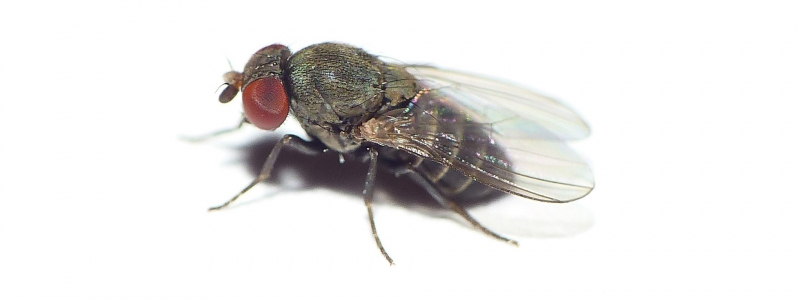||| FROM RUSSEL BARSH for KWIAHT |||
One of the risks of importing Mason bee tubes from the mainland has been the unwitting introduction of pathogens and parasites that could impact the islands’ native Mason bee species, which are important for spring pollination of wildflower meadows and early-flowering shrubs and trees. Commercially-available Mason bees in the Pacific Northwest are mainly Osmia lignaria, the so-called Blue Orchard Mason Bee; but there are thirty other native species of Mason bees in the Salish Sea region, at least eight of which have been identified in the San Juan Islands.
Houdini fly (Cacoxenus indagator), a European parasite of Mason bees, was discovered in New York State in 2011, and first confirmed in the Seattle area in 2020. It presumably has been spread by trade in Mason bees. A distant cousin of the familiar laboratory “fruit fly,” Drosophila melanogaster, Houdini flies lay their eggs in Mason bees’ nests. When they hatch, the fly maggots feast on nectar and pollen meant for larval bees. In the spring, adult flies rather than bees emerge from the Mason bees’ nests. The newly emerged adult flies then search for fresh Mason bee nests to parasitize. In areas where Houdini flies are well established, they can affect a majority of Mason bee nests or nest-tubes, sharply reducing Mason bee survival and pollination services.
The Houdini fly gets its name from the way it manages to escape from Mason bee nests that were sealed with mud the previous summer. Unlike bees, these flies lack the ability to chew. But astonishingly, they can inflate their heads and use them as battering rams. The process may take hours.
What can island gardeners and farmers do?
The first line of defense is to ensure, if you already have Mason bee tubes or “bee hotels,” that you are not raising Houdini flies along with your bees. The simplest way to achieve this is to bag your Mason bee tubes and bee hotels in mosquito netting with fine mesh, 1/16 inch or less, to detain whatever insects may emerge in spring. If there are flies, their prominent red eyes make it easy to distinguish them from Mason bees. Squash the flies, and release the bees. Then dispose of the empty bee tubes; do not reuse them. Wash and bleach the bee hotel.
The second line of defense is to avoid importing any more Mason bees from the mainland, in tubes or bee hotels. Instead, you can support native Mason bees by providing them with more nesting habitat—including empty, previously unused bee hotels, as well as stumps and snags that have beetle and woodpecker borings. You can also provide habitat in your landscaping for some of the other wild native bee species that live in the islands, including Bumblebees and Miner bees that also—like Mason bees—emerge relatively early for spring pollination.
Contact info@kwiaht.org for additional information on attracting wild native bees.
**If you are reading theOrcasonian for free, thank your fellow islanders. If you would like to support theOrcasonian CLICK HERE to set your modestly-priced, voluntary subscription. Otherwise, no worries; we’re happy to share with you.**









Thanks for alerting readers to this invasive pest. Crown Bees has an informative video with photographs of the adult houdini fly and the maggot stage:
https://crownbees.com/blog/houdini-fly-alert-for-mason-bee-raisers/
For those who raise mason bees an important management technique for pests is to open nesting tubes in October, wash and clean the bee cocoons, and destroy or discard parasites. Store the cocoons in a cool location such as a refrigerator in a container that will maintain a humidity level of at least 30% until it’s time for release in April.. In the six years that the master gardeners have been providing mason bees and nesting materials at the Orcas School we have found common kleptoparasites such as hairy fingered mites and carpet beetles as well as the true parasite Monodontomerus wasp. So far we have not found any houdini fly maggots or adults.
There will be a workshop on raising mason bees on March 4 at 1:30 PM in the Orcas Library community room. In addition to showing various types of nesting materials we’ll have educational materials for children about mason bees.